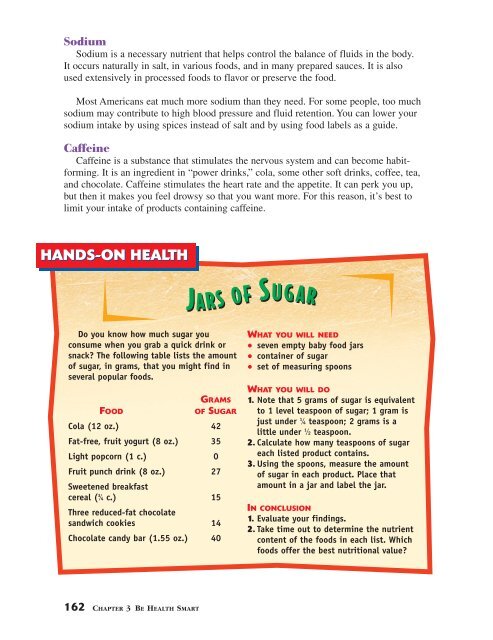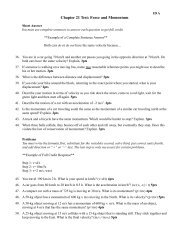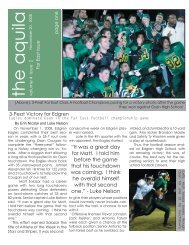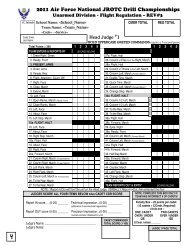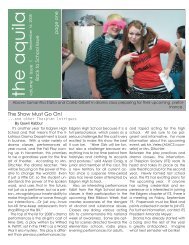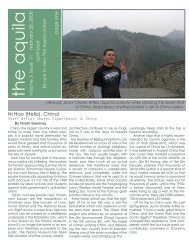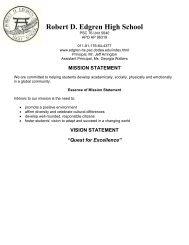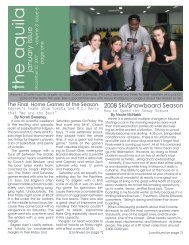AFJROTC Student Workbook CH03_Lesson_2 - Edgren High ...
AFJROTC Student Workbook CH03_Lesson_2 - Edgren High ...
AFJROTC Student Workbook CH03_Lesson_2 - Edgren High ...
Create successful ePaper yourself
Turn your PDF publications into a flip-book with our unique Google optimized e-Paper software.
<strong>CH03</strong>_LE1 6/28/05 4:19 PM Page 162<br />
Sodium<br />
Sodium is a necessary nutrient that helps control the balance of fluids in the body.<br />
It occurs naturally in salt, in various foods, and in many prepared sauces. It is also<br />
used extensively in processed foods to flavor or preserve the food.<br />
Most Americans eat much more sodium than they need. For some people, too much<br />
sodium may contribute to high blood pressure and fluid retention. You can lower your<br />
sodium intake by using spices instead of salt and by using food labels as a guide.<br />
Caffeine<br />
Caffeine is a substance that stimulates the nervous system and can become habitforming.<br />
It is an ingredient in “power drinks,” cola, some other soft drinks, coffee, tea,<br />
and chocolate. Caffeine stimulates the heart rate and the appetite. It can perk you up,<br />
but then it makes you feel drowsy so that you want more. For this reason, it’s best to<br />
limit your intake of products containing caffeine.<br />
HANDS-ON HEALTH<br />
JARS OF<br />
JARS OF<br />
SUG AR<br />
SUG AR<br />
Do you know how much sugar you<br />
consume when you grab a quick drink or<br />
snack The following table lists the amount<br />
of sugar, in grams, that you might find in<br />
several popular foods.<br />
FOOD<br />
GRAMS<br />
OF SUGAR<br />
Cola (12 oz.) 42<br />
Fat-free, fruit yogurt (8 oz.) 35<br />
Light popcorn (1 c.) 0<br />
Fruit punch drink (8 oz.) 27<br />
Sweetened breakfast<br />
cereal ( 3 / 4 c.) 15<br />
Three reduced-fat chocolate<br />
sandwich cookies 14<br />
Chocolate candy bar (1.55 oz.) 40<br />
WHAT YOU WILL NEED<br />
• seven empty baby food jars<br />
• container of sugar<br />
• set of measuring spoons<br />
WHAT YOU WILL DO<br />
1. Note that 5 grams of sugar is equivalent<br />
to 1 level teaspoon of sugar; 1 gram is<br />
just under 1 / 4 teaspoon; 2 grams is a<br />
little under 1 / 2 teaspoon.<br />
2. Calculate how many teaspoons of sugar<br />
each listed product contains.<br />
3. Using the spoons, measure the amount<br />
of sugar in each product. Place that<br />
amount in a jar and label the jar.<br />
IN CONCLUSION<br />
1. Evaluate your findings.<br />
2. Take time out to determine the nutrient<br />
content of the foods in each list. Which<br />
foods offer the best nutritional value<br />
162 CHAPTER 3 BE HEALTH SMART


